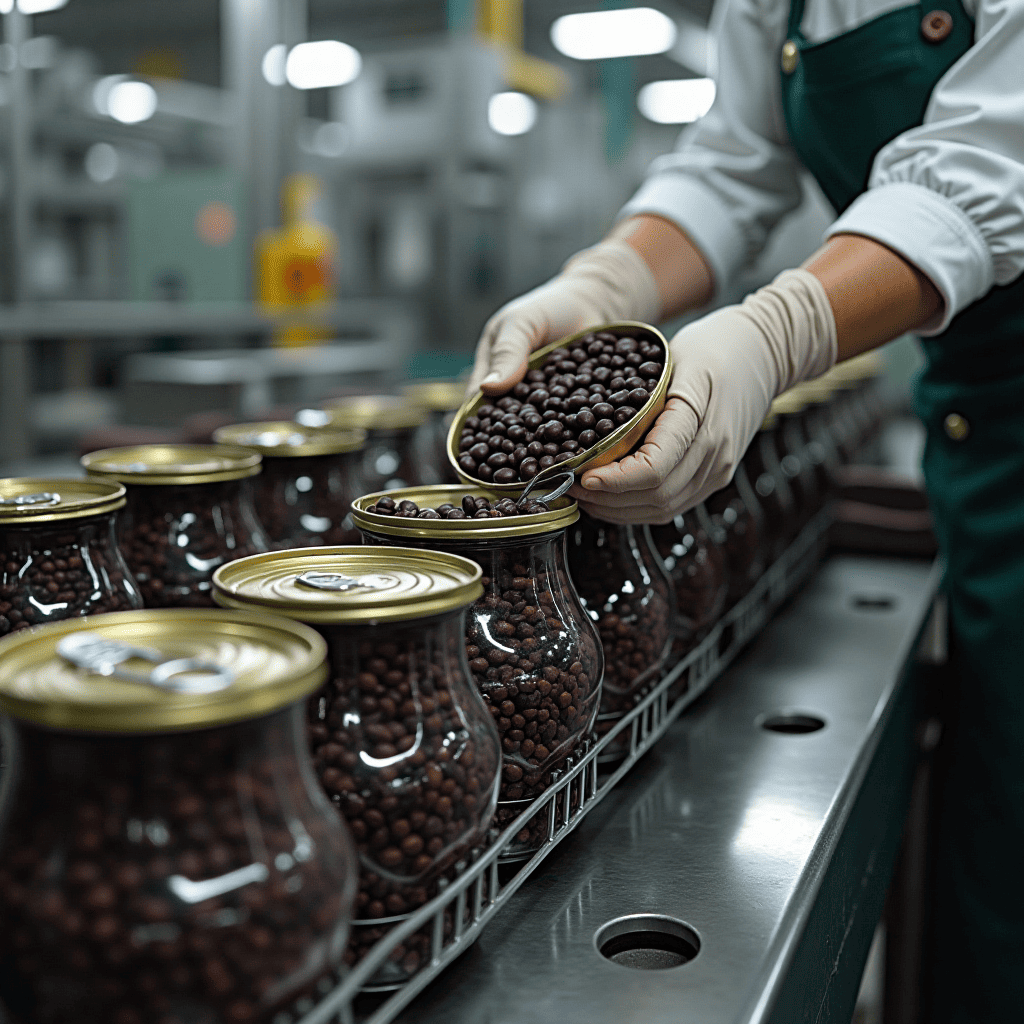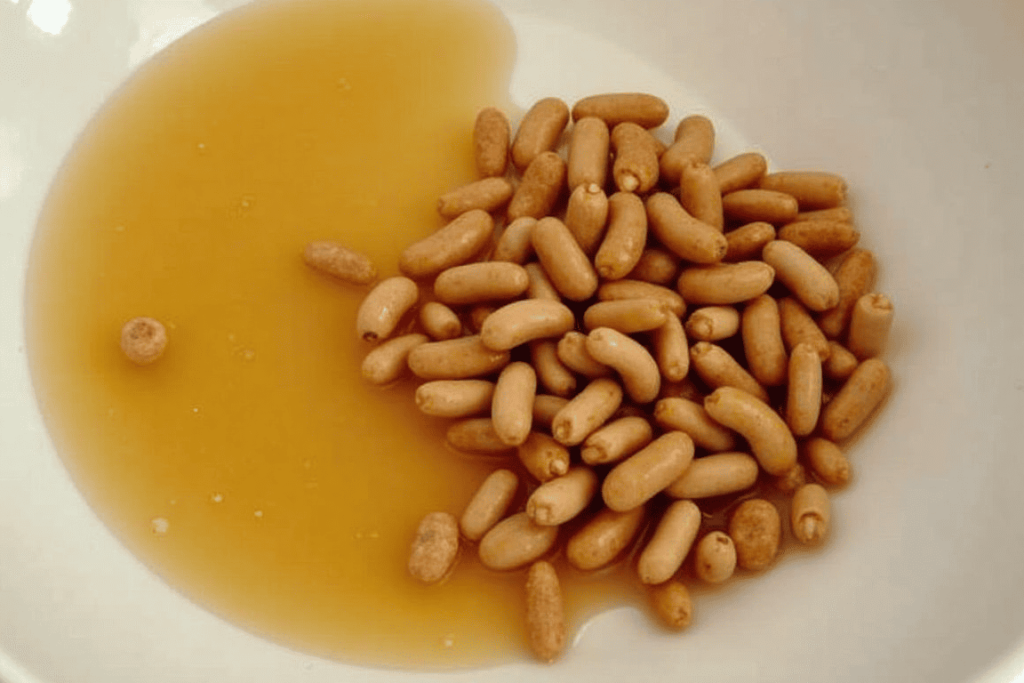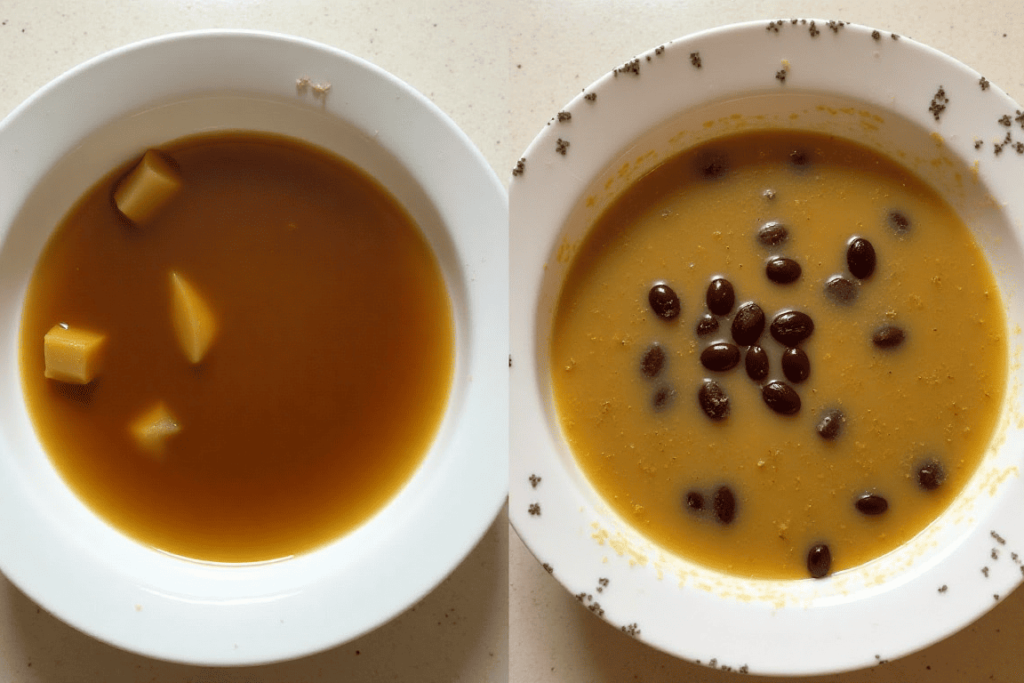Table of Contents
Understanding Canned Black Beans: A Pantry Essential
Canned black beans are a staple in many kitchens, prized for their convenience, nutrition, and versatility in countless recipes. A common question that arises is: Should I rinse canned black beans for soup? Understanding this step and the role of the liquid they’re packed in can help you make the most of this ingredient and elevate your dishes.
How Are Canned Black Beans Made?
Canned beans undergo an intricate process to make sure they’re healthy to consume, durable and simple to utilize. Here’s how they’re prepared:
Ditch Dinner Stress — Cook Smart, Not Hard 🍽️
35 quick & budget-friendly 5-ingredient dinners to save your evenings. Simple. Delicious. Ready in 30 minutes or less.

Selection and Cleaning: High-quality black beans are chosen and thoroughly cleaned to remove any dirt or debris.
Soaking: The beans are pre-soaked to soften their texture and prepare them for cooking.
Partial Cooking: After soaking, the beans are steamed or boiled to cook them partially. This step shortens the cooking time for consumers and makes the beans easier to digest.
Canning and Sterilization: The beans are packed into cans with a liquid medium—usually water, brine, or a light solution with preservatives. The cans are then sealed and sterilized through pressure cooking. This method kills bacteria, extends shelf life, and locks in flavor and nutrients.
What’s the Deal with the Liquid in Canned Beans?
The liquid in canned black beans is more than just a filler—it plays an important role both during canning and in cooking.
What Is the Liquid?
The liquid, sometimes called “bean broth,” is typically a mix of water, natural starches from the beans, and sometimes salt or other additives. These starches give the liquid a slightly thick, almost silky texture.
Why Does the Liquid Matter?
- Preservation
- It keeps the beans moist and prevents them from drying out or becoming mushy.
- Flavor and Nutrition
- During the cooking process, the liquid absorbs flavors and nutrients from the beans, making it a tasty and nutrient-rich addition to recipes.
- Versatility
- Some cooks use the liquid to add flavor or texture to soups, sauces, and other dishes. However, its strong bean flavor or added salt might not suit all recipes.
Should You Use or Rinse the Liquid?
Deciding whether to use the liquid depends on your recipe and dietary needs:
- Use It
- If you want to enhance the flavor or thickness of your dish, the liquid can be a valuable ingredient.
- Rinse It
- For a milder taste, lower sodium content, or recipes where the bean flavor might overpower other ingredients, rinsing the beans is a good option.
By understanding how canned black beans are processed and the role of the liquid, you can make informed choices in the kitchen. If you decide to use them in their original form or wash them and alter the canned beans, they can be a useful and adaptable ingredient to any dish.
Pros and Cons of Rinsing Canned Black Beans
Canned black beans are a convenient and nutritious option for many recipes, but the decision to rinse them can impact their flavor, texture, and nutritional value. Understanding the benefits and drawbacks of rinsing these beans can help you make an informed choice based on your culinary and dietary needs.
Benefits of Rinsing Canned Black Beans
Rinsing canned black beans under cold water removes the liquid they are packed in, which can significantly alter their taste and nutritional profile in certain dishes.
Reducing Excess Sodium
One of the primary advantages of rinsing canned black beans is the reduction of sodium content. Many canned beans are packed in a brine solution that contains a significant amount of salt to enhance flavor and preservation. By rinsing the beans thoroughly, you can remove a large portion of this sodium, making them a healthier option for individuals watching their salt intake.
Removing the Metallic Taste
The liquid in canned beans can sometimes absorb a slight metallic taste from the can’s lining, particularly in older or improperly stored cans. Rinsing the beans helps eliminate this metallic flavor, allowing their natural, earthy taste to shine through in recipes.
Improving Overall Texture
Rinsing can improve the texture of canned black beans by removing the slightly viscous liquid in which they are packed. This liquid, while harmless, can make the beans feel slimy or overly soft. By rinsing, you can achieve a cleaner, firmer texture that works better in salads, tacos, and other recipes where a more structured bean is desirable.
Drawbacks of Rinsing Canned Black Beans
While rinsing offers several advantages, it is not without drawbacks. Depending on the recipe, rinsing may impact the beans’ utility and nutritional value.

Loss of Nutrients
The liquid in canned black beans contains some nutrients that leach out of the beans during the cooking and canning process, including proteins, starches, and certain vitamins and minerals. Rinsing the beans washes away this liquid, leading to a slight loss of these nutrients. While the impact is minimal, it is worth considering for recipes where maximum nutrient retention is a priority.
Reduced Thickness in Soups and Stews
In dishes such as soups, stews, and chili, the liquid from canned beans can act as a natural thickener due to its starchy consistency. By rinsing the beans, you lose this thickening agent, which might result in a thinner, less hearty dish. For recipes relying on a rich and creamy texture, retaining the liquid may be beneficial.
By weighing the pros and cons, you can decide whether rinsing canned black beans is appropriate for your specific recipe or dietary requirements. While rinsing can improve taste and reduce sodium, keeping the liquid can enhance thickness and retain nutrients, making it a flexible choice based on your needs.
How Rinsing Affects Soup Flavor and Consistency
Rinsing canned black beans can have a significant impact on the flavor and consistency of soups. Depending on your culinary goals, you may choose to rinse the beans for a lighter, cleaner taste or retain the liquid for a richer, thicker base.

When to Rinse for a Lighter, Cleaner Flavor
Rinsing canned black beans is ideal when you want the soup to have a more delicate, cleaner flavor profile. The liquid in canned beans contains natural starches, salt, and sometimes preservatives, which can introduce a stronger bean taste or an unwanted briny or metallic note to the soup.
Rinsing is particularly useful in soups where the black beans are one of many ingredients, and you want their flavor to blend subtly with others, such as in:
- Vegetable soups: Rinsing allows the fresh flavors of the vegetables and herbs to shine without being overshadowed by the bean liquid.
- Brothy soups: For clear or light broths, rinsing ensures the soup remains translucent and free from the murkiness of the bean liquid.
Rinsing also helps control sodium levels, especially in soups where you are seasoning the broth separately.
When to Skip Rinsing for a Richer, Thicker Base
Retaining the liquid from canned black beans can enhance the soup’s body and flavor, making it richer and heartier. The starchy liquid adds thickness and depth, which is especially valuable in:
- Chilis and stews: The starches contribute to a creamy consistency and a more robust flavor, integrating seamlessly with the spices and other ingredients.
- Pureed soups: When blending soups that feature black beans as a primary ingredient, the liquid enhances the smoothness and richness of the final texture.
Choosing the Right Approach
Whether to rinse or not depends largely on the recipe and your desired outcome. Rinse canned black beans for a fresher, lighter soup, and skip rinsing when you want a hearty, full-bodied dish with enhanced thickness. Understanding these nuances allows you to tailor your approach to achieve the perfect balance of flavor and consistency.
Step-by-Step Guide to Rinsing Canned Black Beans
Rinsing canned black beans is a quick and simple process that helps reduce sodium, improve texture, and enhance the flavor of your dishes. Follow this step-by-step guide to ensure your black beans are properly rinsed and ready to use.
Materials You’ll Need
Before you begin, gather the following items:
- A colander or strainer: To hold the beans while allowing liquid to drain.
- A large bowl (optional): To catch the liquid if you plan to reserve it for another purpose.
- Access to cold running water: Essential for rinsing thoroughly.
- Paper towels or a clean kitchen towel (optional): To pat the beans dry if needed for a specific recipe.
A Simple Rinsing Process
Rinsing canned black beans involves just a few straightforward steps to ensure they are clean and free from the canning liquid.
Using a Colander or Strainer
- Open the can of black beans and pour its contents into a colander or strainer. If you wish to save the liquid for thickening soups or stews, place a bowl underneath the colander to catch it.
- Gently shake the colander to drain the initial liquid from the beans.
Rinsing Under Cold Water
- Place the colander under a stream of cold running water. Cold water is ideal for rinsing as it refreshes the beans without altering their texture.
- Use your hand or a spoon to stir or toss the beans while rinsing lightly. This ensures all beans are exposed to the water.
Shaking for Uniform Rinsing
- Once the water draining from the beans runs clear (indicating the removal of most of the starches and brine), give the colander a few firm shakes. This helps remove any excess water from the beans.
- Inspect the beans for any residual canning liquid or foam, and continue rinsing if necessary.
Additional Tips
- Pat Dry if Needed: For recipes like salads or roasted black beans, use a paper towel or clean kitchen towel to pat the beans dry after rinsing to prevent excess moisture.
- Skip Rinsing for Some Recipes: If the canning liquid is needed to thicken a dish, omit this process and simply drain the beans before use.
By following these steps, your canned black beans will be ready for any dish, with improved flavor and reduced sodium.
Myths About Rinsing Canned Black Beans
Rinsing canned black beans is a common practice, but there are several misconceptions surrounding its impact on taste, safety, and nutrition. Understanding the truth behind these myths can help you make informed decisions about preparing canned black beans.
Does Rinsing Always Improve Taste?
Myth: Rinsing canned black beans always makes them taste better.
Truth: While rinsing can improve the flavor by removing the salty or metallic taste of the canned liquid, it’s not always necessary. In some recipes, such as stews or chilis, the liquid adds depth and richness to the dish. Whether rinsing improves the taste depends on the recipe and personal preference.
- Rinsing is ideal for fresh, light dishes like salads or tacos, where a clean bean flavor is desirable.
- Retaining the liquid can enhance flavor in hearty, spiced dishes, as the bean liquid contributes to the overall complexity.
Is the Liquid Always Harmful?
Myth: The liquid in canned black beans is harmful or unhealthy.
Truth: The liquid is not inherently harmful. It consists mostly of water, starches, and sometimes salt or preservatives. The main concern with the liquid is its sodium content, which can be high in some brands. However, low-sodium or no-salt-added options are widely available for those concerned about sodium levels.
- The liquid can be a useful ingredient, particularly as a thickener in soups or sauces.
- If you’re avoiding added preservatives or sodium, rinsing is an effective way to mitigate these concerns without discarding the beans entirely.
Does Rinsing Waste Nutrients?
Myth: Rinsing canned black beans wastes significant nutrients.
Truth: While rinsing removes some nutrients, particularly water-soluble ones like certain vitamins and minerals, the amount lost is relatively small. The primary nutritional value of black beans—fiber, protein, and carbohydrates—remains intact after rinsing.
- Retaining the liquid may help preserve a small amount of the lost nutrients, but the impact on the overall nutritional profile is minimal.
- Rinsing is a trade-off between slightly reduced nutrient content and improved control over taste and sodium levels.
FAQs About Rinsing Canned Black Beans
Should I rinse canned black beans for every recipe?
No, rinsing is not always necessary. Whether to rinse depends on the recipe and desired outcome:
- Rinse for recipes like salads, tacos, or grain bowls where a clean flavor and firm texture are preferred.
- Skip rinsing for dishes like soups, stews, and chilis, where the bean liquid can add thickness and flavor.
Can I use the liquid from canned black beans in soup?
Yes, the liquid can be used in soup. It acts as a natural thickener due to its starchy consistency and enhances the dish with bean flavor. However:
- Be mindful of the sodium content in the liquid, especially in salty recipes.
- If you prefer a lighter flavor or clearer broth, you might choose to omit the liquid.
Best Practices for Using Canned Black Beans in Soup
Canned black beans are a versatile ingredient for soups, offering convenience, flavor, and nutrition. Whether you’re preparing a clear broth soup or a creamy, pureed version, using canned beans effectively can elevate your dish. Here are the best practices for handling canned black beans in soup recipes.
- Clear Broth Soups: Always rinse canned black beans for soups where clarity and a clean flavor are essential. For example, consider rinsing beans for recipes similar to Do You Need to Soak Black Beans Before Making Soup?
- Creamy or Pureed Soups: Retaining the liquid can help achieve a rich texture. It’s particularly effective in soups like Remove Bitterness in Black Bean Soup: Tips & Solutions, where the thick consistency and intense flavor are key.
Tips for Optimal Use
- Combine techniques: For some recipes, you can rinse half the beans for texture and retain the liquid from the rest for added thickness.
- Season to taste: If using the liquid, be mindful of its salt content and adjust your seasoning accordingly.
- Experiment: Try using the liquid sparingly in soups that require a balance between clarity and thickness, like black bean tortilla soup.
Conclusion: To Rinse or Not to Rinse?
The decision to rinse canned black beans ultimately depends on your recipe, dietary goals, and personal preferences. Both rinsing and retaining the liquid offer unique benefits that can enhance different dishes.
- Rinse the beans if you want to reduce sodium, remove the briny or metallic taste, or achieve a firmer texture. This is ideal for recipes like salads, grain bowls, or soups with clear broths, where a clean and light flavor is desirable.
- Retain the liquid if you’re aiming for a thicker, creamier consistency or a richer flavor profile. The liquid works well in chilis, stews, and pureed soups, where its starches can enhance the texture and depth of the dish.
By tailoring your approach, you can create soups that meet your taste and nutritional preferences. For more ideas and recipes featuring black beans, explore resources like the Purple Black Bean Soup Recipe for inspiration.
